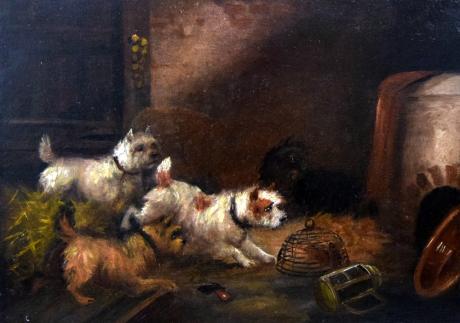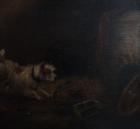George Armfield Smith (better known as George Armfield) was born, and lived most of his life in London. George Armfield is probably the most prolific dog painter of the nineteenth century. He painted dogs almost exclusively and produced innumerable charming scenes of terriers surrounding rabbit holes, spaniels putting up mallard, ratting terriers, and groups of sporting dogs in interiors. A small beribboned spaniel curled up on top of a large barrel is often featured. A few early subjects also include "The Dying Stag," "The Wolf and the Lamb," and several fox paintings with dead pheasants or badgers.
George Armfield was born in Wales in the early years of the nineteenth century, although the precise date has not been established. He was the son of an artist, and apparently had a brother, William, who also followed in their father's footsteps, and was sent to Rome to pursue his art education.
Armfield was apprenticed to a fishing tackle maker, but left before the end of his apprenticeship to devote himself to art. He quickly became a successful painter, and from the age of 16 his works were much in demand. He kept a horse from this time, and married when he was 17 or 18. He had no children from this first marriage, but his second wife bore him a daughter, and when he married for the third time, a further 12 children were born.
Initially, George Armfield signed and exhibited his work as G A Smith, changing this when he exhibited the first of his paintings at the British Institution in 1839. Armfield entered two pictures entitled "Study of a Dog's Head" and "Terrier Chasing a Rabbit." The following year his work began to appear regularly in issues of Sporting Magazine. In 1840 Armfield began to exhibit at the Royal Academy. His work was also shown at Suffolk Street. He continued to exhibit regularly over the next twenty years.
Although the majority of his pictures are portraits of dogs, Armfield also painted horses, foxes, otters, deer and rabbits. He was renowned for his love of animals. He kept a small menagerie at his house, and was said to paint his subjects from life, thus accounting for the accuracy and special charm of his subjects. He was a keen sportsman and regularly went shooting, racing and hunting. In addition, Armfield was known to patronize the less reputable dens of dogfights and cockfights. It is recorded that he once spent three months at the Earl of Fitzwilliam’s stables painting the horses and hounds in the kennels.
Armfield earned substantial amounts of money for his painting, but spent it easily, gambling and giving it away to those in need. He was a hard worker, and produced a large number of canvases. Sadly, he began to go blind later in life and was unsuccessfully operated on for this ailment. Acutely depressed by his loss of sight, Armfield attempted suicide. When he recovered, he continued to paint, often aided by a powerful eyeglass, working up close on small canvases. He was reduced to such poverty that the Royal Academy awarded him a pension of £20 per annum. He died in 1893 before drawing the first installment.
George
Armfield
1810 - 1893
Terriers Ratting
Terriers Ratting
oil on canvas
12 x 20in. (30.48 x 50.80 cm.)
£1800
Artist biography



